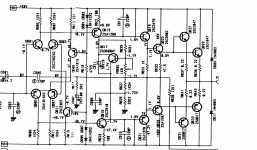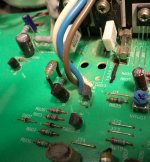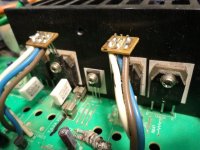Here is the schematic of Rotel RA 970BX as a schematic is nothing that we haven't seen before ...very understandable i think .
Inside the amp there is positions on the PCB for a local heatsink for the drivers individually (4 separated local small heat sinks )
on production though this is not what is done
The 4 drivers are hardwired to be placed not in the main heatsink but screwed together with output transistors as one could do if a Vbe multiplier was the subject
As far as I understand the driver cannot cool down ( or share similar temp like if located on the same heatsink ) if attached to an output transistor this style ...On the contrary the output transistor will heat up the driver from the temperature created on the body ...
1) Can this cause thermal runaway ?
2) will it be wise to move the drivers to the main heat sink ?
Comments please ?
( from the pictures one may see the positions and the local heat sinks together with the drills on the pcb for ventilation . Also thermal runaway might be caused in any case one P driver gets warmer than the N driver but cooling them like that doesn't look right )
Kind regards
Sakis
Inside the amp there is positions on the PCB for a local heatsink for the drivers individually (4 separated local small heat sinks )
on production though this is not what is done
The 4 drivers are hardwired to be placed not in the main heatsink but screwed together with output transistors as one could do if a Vbe multiplier was the subject
As far as I understand the driver cannot cool down ( or share similar temp like if located on the same heatsink ) if attached to an output transistor this style ...On the contrary the output transistor will heat up the driver from the temperature created on the body ...
1) Can this cause thermal runaway ?
2) will it be wise to move the drivers to the main heat sink ?
Comments please ?
( from the pictures one may see the positions and the local heat sinks together with the drills on the pcb for ventilation . Also thermal runaway might be caused in any case one P driver gets warmer than the N driver but cooling them like that doesn't look right )
Kind regards
Sakis
Attachments
Looks like some bean counter was saving costs of extra screws and heat sinks for the drivers. If the thermal strategy of the amp keeps it stable under hot conditions, than I'd say it is fine. BTW: what is the burned looking stuff at bottom center of the last pic?
One may think that for such a "small power amplifier " sharing the same temp with the outputs might be more important than cooling the drivers which one way or another might not suffer much ...
been monitoring temp after the repair Vbe operates perfectly and there is no sign of thermal runaway
Burned looking stuff is *** from my cigarette .... oooops sorry for that ..
been monitoring temp after the repair Vbe operates perfectly and there is no sign of thermal runaway
Burned looking stuff is *** from my cigarette .... oooops sorry for that ..
It looks like a purchasing, design or reuse of the PCB blunder since the flying leads and small PCBs won't be as cheap to fit as a small 'sink. That "small" could have been the problem, only seen after production began.
Since the drivers have almost constant dissipation, I don't see any need or benefit in thermally coupling to the output transistors but possibly, the engineers found this was a more stable arrangement in the EF triple output stage used. Stability in triples is usually addressed in the first transistors, (Q619,621) so I'm not sure about the approach - never tried or even considered it.
Since the drivers have almost constant dissipation, I don't see any need or benefit in thermally coupling to the output transistors but possibly, the engineers found this was a more stable arrangement in the EF triple output stage used. Stability in triples is usually addressed in the first transistors, (Q619,621) so I'm not sure about the approach - never tried or even considered it.
I have another explaination.
What about Vbe sensitivity If its more sensitive bias drops and quality too.
This is "reverse" Vbe which highers the bias, on another hand vbe lowers and finally its neutral. On another hand ofcourse coupling of the drivers is better than local heatsinks. I dont think Thermal Runaway is possible Even with normal sensitivity Vbe. 🙂\
Its possible if they are placed on a heater 😀
Greetings.
What about Vbe sensitivity If its more sensitive bias drops and quality too.
This is "reverse" Vbe which highers the bias, on another hand vbe lowers and finally its neutral. On another hand ofcourse coupling of the drivers is better than local heatsinks. I dont think Thermal Runaway is possible Even with normal sensitivity Vbe. 🙂\
Its possible if they are placed on a heater 😀
Greetings.
I imagine the DC operating point would shift as the output power increases, countering to some extent the Vbe multiplier. Maybe helps against undercompensation that happens as the amp warms up.
The small sinks for the drivers operating at 48V seems too small, but the plastic package of the output device seems a much less suitable surface to attach a driver. A few measurements of the bias at various heatsink temperatures would provide some more insight.
Are R631 and R633 actually connected to the feedback path like the schematic shows? It would be extremely unusual if they were.
The small sinks for the drivers operating at 48V seems too small, but the plastic package of the output device seems a much less suitable surface to attach a driver. A few measurements of the bias at various heatsink temperatures would provide some more insight.
Are R631 and R633 actually connected to the feedback path like the schematic shows? It would be extremely unusual if they were.
There is no reason to cool the drivers. The drivers should track the output devices temp, so when the output heats up, the drivers heat up and the bias goes down. This is a very effective way to avoid thermal runaway. It is more expensive in manufacturing but well worth it for reliability.
These guys knew what they were doing all right!
Jan
These guys knew what they were doing all right!
Jan
There is no reason to cool the drivers. The drivers should track the output devices temp, so when the output heats up, the drivers heat up and the bias goes down. This is a very effective way to avoid thermal runaway. It is more expensive in manufacturing but well worth it for reliability.
These guys knew what they were doing all right!
Jan
Jan, this sounds odd to me. This is not Sziklai. When the driver heats up, the current through it slightly rises, increasing the voltage drop over R633, increasing the bias.
BTW, it looks like there is a mistake on the schematic. R631 and R633, as well as the emitters below (D621, D625), should not be connected to the negative input of the amplifier (bases of D683, D687). It does not make sense at all.
With regards to the drivers - they would feel better on the main heat sink.
Local heatsinks - even better but even more expensive.
Cheers,
Valery
Jan, this sounds odd to me. This is not Sziklai. When the driver heats up, the current through it slightly rises, increasing the voltage drop over R633, increasing the bias.
I would have thought so too...
Well, just thought a bit more - the only idea that comes to my mind - those drivers slightly compensate the bias spreader over-regulation. So, after a long run at high power, the main heatsink is hot and Vbe spreader makes the bias pretty low. If you have a low-volume signal after that - the bias is not optimal. So those drivers can decrease the influence of this effect.
You could also use it to run a low quiescent current at idle and get a bit of an increase when needed. Like some sort of sliding bias.
Then again, it could be maybe someone forgot to buy the driver sinks and then realised that no solution fitted it correctly.
You anyway get this effect when you fix drivers to the main sink, except that thermal inertia would be much greater.
Then again, it could be maybe someone forgot to buy the driver sinks and then realised that no solution fitted it correctly.
You anyway get this effect when you fix drivers to the main sink, except that thermal inertia would be much greater.
Then again, it could be maybe someone forgot to buy the driver sinks and then realised that no solution fitted it correctly.
Yes, but here this is a design approach, so it looks like a partial spreader action compensation with less inertia, than spreader works with.
I think that Valery got it right
Long term monitoring of the temp behavior ( over 24h ) proved it right
The key is the small heat sink and the bias by this approach drivers will:
--share the same heat with outputs or even more
--better than having drivers warming up on their own
--if heat exists bias will rise accordingly
--Then Vbe will have to take it down
Checked the bias in static conditions and works alike
Similar procedure on the bias when play conditions either high or low power
Kind regards
Sakis
Long term monitoring of the temp behavior ( over 24h ) proved it right
The key is the small heat sink and the bias by this approach drivers will:
--share the same heat with outputs or even more
--better than having drivers warming up on their own
--if heat exists bias will rise accordingly
--Then Vbe will have to take it down
Checked the bias in static conditions and works alike
Similar procedure on the bias when play conditions either high or low power
Kind regards
Sakis
Yes, but here this is a design approach, so it looks like a partial spreader action compensation with less inertia, than spreader works with.
No this a standard practice to other Rotel amplifiers as well
No this a standard practice to other Rotel amplifiers as well
Than's what I mean 😎
- Status
- Not open for further replies.
- Home
- Amplifiers
- Solid State
- Weird driver cooling approach


